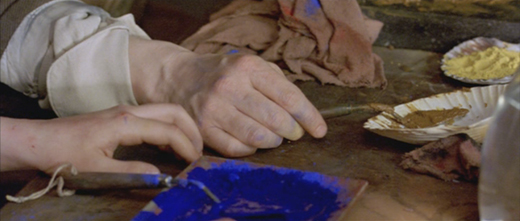Girl with a pearl earring
Peter Webber

The eponymous girl in Peter Webber's adaptation of Tracy Chevalier's astonishing first novel, falls in lover with the man whom everyone calls "her master," and he, in turn, captures this love in a painting. You might say that Griet (Scarlett Johansson) is a housemaid with benefits, the benefits being her access to a man whose artistry, as the daughter of a blinded tile-painter, she can appreciate. She can help him mix his paints! She even proposes the elimination of an intrusive chair from the composition of what we know will become a very famous painting. Ms Johannson plays her largely silent role with what can only be lauded as generous tact; she brings to mind a sense of the physical restraints that kept servants in their place, felt all the more sharply because Griet was not raised for such a fate. Once she discovers the artist's magnificence, she cannot help but fall in love with him.
The artist has a wife and a mother-in-law. With the wife, he makes babies, almost heedlessly, one after the other. But Catharina (Essie Davis) is not cut out for supporting roles. Pretty and vain, she envies the attention that her husband lavishes on his work — even, one imagines, when he is with her. She envies all the more the time that Griet spends with her husband, having been chosen as his model by a lascivious patron (Tom Wilkinson). The mother-in-law, called Maria Thins (Judy Parfitt), is more unusual. Without words having been spoken, we know that Maria is a businesswoman who has decided to underwrite the artist's career — not a foolish investment in Seventeenth-Century Holland. But to invest in this particular artist has proved to be a disappointment. Maria appreciates the excellence of his pictures, but there is no getting round the fact that he takes too long to paint them.
He is Jan Vermeer (Colin Firth), and, when he dies, at the age of forty-three, he will leave behind a total of thirty-six canvases. (His rough contemporary, Pieter de Hooch, lived to be about ten years older, but eighty-four pictures are attributed to him.) More than half of them, easily, will be regarded as masterpieces. The film helps us to understand why, and, in doing so, it sheds more light on "the creative process" than any other film that I've seen. Mr Webber's Vermeer is fascinated to the point of boorish impatience by the problems that he sets himself in his second-storey studio. First, there is the problem of how to see. How to see what is there, how to see beyond what we need to see to get on with our lives: this is the great goal of representational art. The great challenge is getting it down on canvas, and Mr Webber shows us a bit of this one as well; but it is mostly the difficulty of seeing clearly that he presses upon us, in our unawareness that we had any difficulty with it whatsoever.
It is possible that the Vermeer presented in this movie is the very type of Sigmund Freud's sublimated man. Because Freud saw in the libido the only possible source of and explanation for the great things that men do, over and beyond all consideration of physical gratification, his psychology of the creative individual has an ascetic tinge, as though the price of artistic genius were worldly — and especially sexual — renunciation. (Indeed, one thinks of the coaches who discourage their athletes from having sex on the eve of a big game.) We know, however, that the geniuses of Western art have tended to be more like Mozart than Beethoven. (Try to imagine Beethoven writing a love-letter about his erections!) The sublimated man who pours himself into high-order challenges is not empowered by turning his back on low-order appetites, but by domesticating them, as Jan Vermeer apparently did. And, if he is a painter, he must engage in some kind of seduction, obviously enough, in order to make the girl with the pearl earring appear before him. We like to think of artists as fanciful and inventive, but that is precisely what they are far too disciplined to be. Peter Webber's disciplined tribute is not unworthy of its subject. (September 2009)

Copyright (c) 2009 Pourover Press